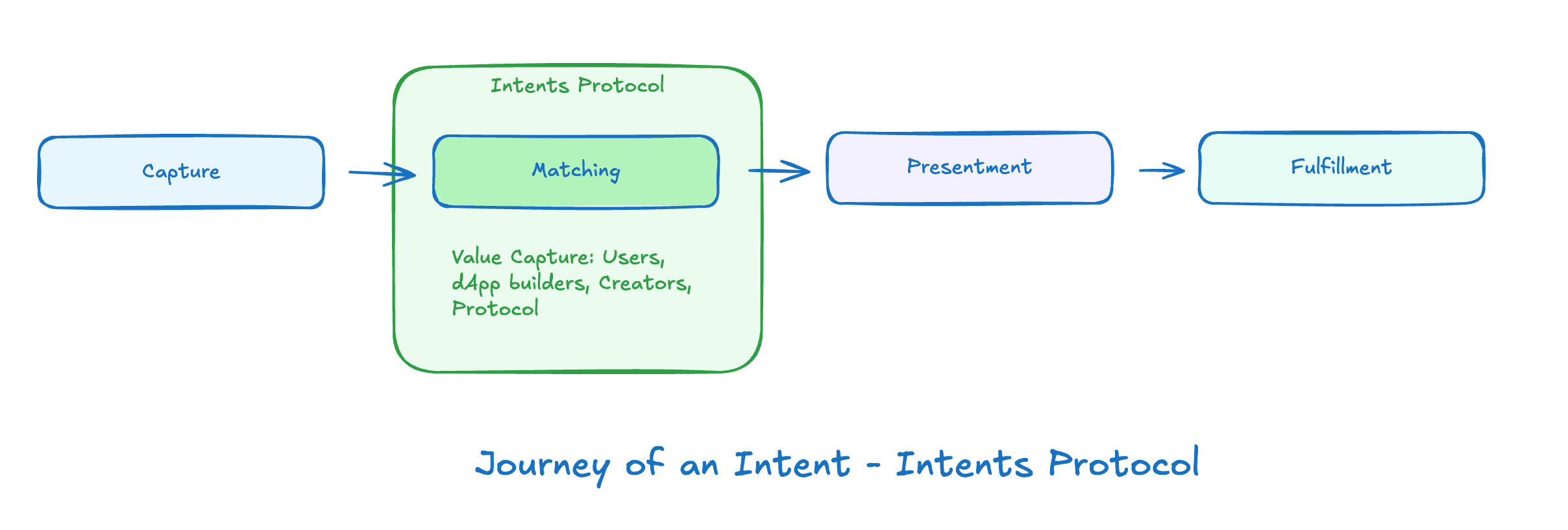Beyond the Black Box: An Open Protocol for User Intent, Powering a User-Centric Web
The digital world operates on a continuous flow of user intent. Every online action, from a specific search query to passive browsing, signals a need or desire. This collective intent is the lifeblood of an immense digital economy. Understanding the journey this intent undertakes – from its initial expression to its ultimate fulfillment – is key to unlocking a more innovative, transparent, and user-centric internet. This journey can be broadly understood through four critical stages: Capture, Matching, Presentment, and Fulfillment.
The Digital Intent Journey: A Closer Look at Today's Landscape

Intent Journey Today
Users express intent in myriad ways. For instance, someone looking for a new computer might explicitly type "best laptops for photo editing under $1500" into a search engine. Alternatively, their intent could be captured implicitly as they browse review sites for high-performance laptops or watch video reviews of creative software. Publishers also play a role, noting engagement with content related to powerful computing.
2. Intent Matching: The Current Nexus of Value and Control
This is the critical juncture where expressed or inferred intent is connected with relevant products or services. Continuing our laptop example, the search engine's powerful matching algorithms would process the "best laptops for photo editing" query.
These systems rely on:
Access to vast streams of explicit and implicit user intent data.
Extensive catalogues of products and services from advertisers (like Dell, Apple, HP).
Detailed campaign parameters (bids, budgets).
A complex, real-time auction then determines which laptop ads are deemed the "best match" to show the user. It's here that the platform's matching engine orchestrates the connection and captures significant value. This stage represents a massive market; global digital advertising spending, where much of this intent matching occurs, is projected to exceed $800 billion in 2025 and continues to climb. Reports from industry analysts like eMarketer consistently show that a few dominant tech companies capture the lion's share of this revenue, highlighting the intense concentration of power within this "Matching" stage. For example, it's often cited that companies like Google and Meta have historically held a combined market share of around 50% or more of the global digital ad market.
3. Intent Presentment: Delivering the Connection
The output of the matching process – an advertisement or sponsored listing – is then presented to the user. In our laptop scenario, the user would see ads for specific models like a Dell XPS 15, an Apple MacBook Pro, or an HP Spectre appearing prominently in their search results or on websites they visit later.
4. Intent Fulfillment: The User's Need Met
This is the point of action. The user, having seen the ads, might click on the Dell XPS 15 ad, explore its features on the Dell website, and proceed to purchase it. Their intent to find a suitable laptop for photo editing is (hopefully) satisfied through this transaction. The emergence of sophisticated AI agents promises to significantly transform this stage, moving towards more automated and proactive fulfillment.
The Bottleneck and the Breakthrough: Reimagining 'Matching' with an Intents Protocol
The current concentration and opacity within the "Matching" stage, while a testament to significant technological achievement, can also limit broader innovation and user agency. The pivotal opportunity lies in re-architecting this "Matching" component with an open, transparent "Intents Protocol" designed as a foundational utility for the internet.
This isn't merely a theoretical desire; users are increasingly concerned about how their data is handled. For example, a 2023 Pew Research Center study found that a large majority of U.S. adults (around 79%) are concerned about how companies use their personal data, and a significant portion (around 81%) feel they have very little to no control over the data that companies collect about them. This widespread sentiment underscores the urgent need for more user-centric solutions.
To truly replace current matching engines and offer a superior alternative, an Intents Protocol needs to not only replicate their core functionalities but also enhance them with greater transparency, user control, and fairness. That's precisely our focus in developing the Intents Protocol, ensuring it's equipped with the following comprehensive capabilities:
Management of User Intents: Enables users to express, own, and manage their structured intents as verifiable digital assets for precise matching.
Access to Product Data: Provides access to comprehensive product data (real-time pricing, availability, reviews) crucial for relevant matches.
Seller/Advertiser Interfaces: Offers dedicated interfaces for sellers and advertisers to discover anonymized intents and submit targeted offers.
Transparent Bidding & Incentives: Marks a departure from what many perceive as inefficient keyword auction models. Advertisers often voice concerns about rising costs-per-click (CPCs) in mature markets and the general opacity in how ad auction dynamics determine placement and price on major platforms (insights often echoed in industry surveys or reports from advertising technology analysts). An Intents Protocol would feature a clear bidding mechanism with robust economic and governance incentives for fair, sustainable operation.
Developer Ecosystem Tools: Provides an open foundation with tools (SDKs, APIs) for diverse application development on the matching infrastructure.
Agentic Action Layer: Includes an agentic layer for AI agents to securely act on users' behalf based on permissioned intents.
User-Controlled Data Stores: Integrates with personal data stores, allowing users to control, permission, and potentially monetize their data.
Community-Driven Governance: Employs a robust governance layer for transparent, open operation aligned with community and user interests.

Intent Journey - New
Innovations Unleashed: Examples of a User-Centric Web
With these comprehensive capabilities foundational to the Intents Protocol, developers are empowered to unleash innovation. They can focus on crafting novel experiences at the Intent Capture and Presentment stages, creating diverse applications and services without the burden of building or navigating complex underlying matching and monetization infrastructure. This new foundation unlocks a spectrum of innovative applications and value-exchange models, placing greater control with users.
Here are a few examples of the kinds of applications and experiences this new paradigm enables:
User-Centric Social Platforms: Social networks where permissioned user intents (e.g., "sustainable travel") fetch relevant, transparent offers via the protocol, potentially sharing revenue back with users.
Decentralized Verified Review Systems: The problem of fake online reviews is significant, eroding consumer trust. Reports from organizations like the World Economic Forum or various consumer protection agencies have highlighted its prevalence, with some estimates suggesting that a substantial percentage of online reviews could be inauthentic. Protocol-verified purchases can enable incentivized, tamper-proof reviews, which can then be licensed by commerce sites to enhance trust and combat this multi-billion dollar issue.
Specialized AI Concierge Services: AI concierges (e.g., a 'ChronoAgent' for watches) can refine complex user intents, submit them to the protocol for vetted dealer offers, and curate results, earning transparent fees for expert service.
These examples offer just a glimpse into the vast possibilities. By transforming intent into a user-owned asset and providing an open matching layer, the Intents Protocol empowers builders to innovate across the entire digital journey—expanding user choice, significantly boosting transparency, and distributing economic benefits more equitably.
Conclusion: Building a More Open, Innovative, and Equitable Digital Future
The journey to a truly open internet is complex, and the Intents Protocol, as envisioned, is not a silver bullet for every challenge in digital advertising or intent matching. However, it directly confronts a critical component: the monetization layer that underpins much of the internet’s current power structure.
By striving to make this open commerce layer transparent and user-centric, the Intents Protocol aims to lay a robust foundation for the next wave of internet applications – applications built within a more equitable paradigm. Open matching, centered on user-owned intent, can unlock a wealth of fresh services, fairer economic models, and profoundly innovative new business models.
This is an invitation to join the movement towards this future. Explore the possibilities, create your first intent, and experience the potential difference at www.inomy.shop
